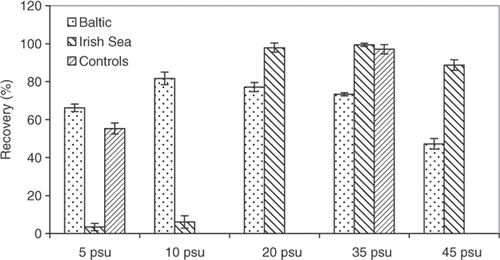Figures & data
Table 1. The content of the major elements (B, Ca, Cl, K, Mg, Na and S) and nutrients (NH4, NO3 and PO4) in artificial seawater (ASW) of different salinities, and for natural seawater (NSW) from the Irish Sea (37.4 psu) and the Bothnian Sea (4.6 psu). The concentrations of B, Ca, Cl, K, Mg, Na and S, are expressed in mmol l−1, whereas the concentrations of the NH4, NO3 and PO4 are expressed in μmol l−1. The analysis was performed by LMI AB, Helsingborg, Sweden.
Fig. 1. Photosynthesis, expressed as absolute electron transport rate (Abs ETR), as a function of irradiance for Fucus vesiculosus from the Gulf of Bothnia (northern Baltic, 5 psu) and from the Irish Sea (35 psu). Measurements were performed with thallus tips (n = 10). Irradiance was increased stepwise from 20 to 600 µmol m−2 s−1, with 5 min at each irradiance and 5 min darkness in between. Temperature = 10°C. Error bars are 95% confidence intervals.

Fig. 2. Saturated photosynthetic rate (Abs ETRmax) of Fucus vesiculosus from the Gulf of Bothnia (northern Baltic, 5 psu; grey) and the Irish Sea (35 psu; black) at different temperatures. Plant tips (10 g FW each, n = 10) were cultivated in their natural seawater for 1 week at 100 µmol m−2 s−1 under a 10 : 14-h light–dark cycle. Means with the same letter are not significantly different at p = 0.05 (Tukey tests).
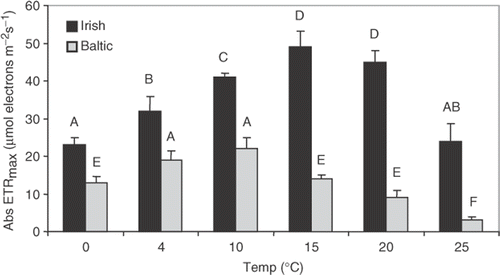
Fig. 3. Saturated photosynthetic rate (Abs ETR) of Fucus vesiculosus from (a) the Gulf of Bothnia (northern Baltic, 5 psu) and (b) the Irish Sea (35 psu), cultivated at different salinities for 5 weeks. Two concentrations of dissolved inorganic carbon (DIC) were used (Low C = 1.0 mol DIC m−3; High C = 2.0 mol DIC m−3) as well as two concentrations of nutrients (Low = 3 µmol NO3 l−1, 0.185 µmol PO4 l−1, 0.05 µmol NH4 l−1; High = 12 µmol NO3 l−1, 0.75 µmol PO4 l−1, 0.2 µmol NH4 l−1). Abs ETR measured after 5-min exposure to 400 µmol m−2 s−1, after a 10 min dark adaptation. Histograms show means of 10 replicates and error bars are 95% confidence limits.
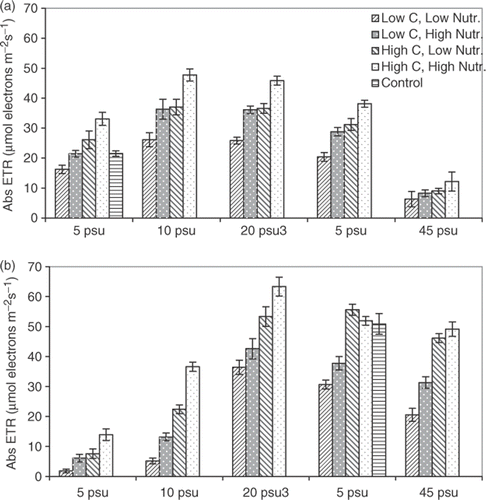
Fig. 4. Relative growth rate (RGR) of Fucus vesiculosus from (a) the Gulf of Bothnia (northern Baltic, 5 psu) and (b) the Irish Sea (35 psu), cultivated at different salinities for 5 weeks (nutrient and DIC concentrations as in ). RGR estimated from changes in dry weight (DW) and expressed as g (DW) per g (DW) and day. Histograms show means of 10 replicates and error bars are 95% confidence limits.
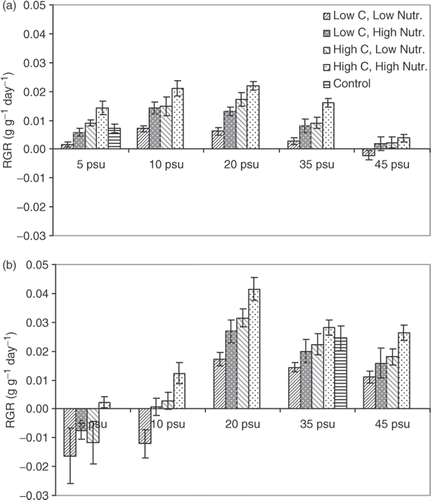
Fig. 5. Correlation between photosynthetic rate (ETRmax) and growth rate (RGR) for Fucus vesiculosus from the Gulf of Bothnia (•) and the Irish Sea (+). Both variables measured after 5 weeks’ cultivation at different salinities (5, 10, 20, 35 and 45 psu) with different nutrient concentrations (see ) and inorganic carbon concentrations (1.0 or 2.0 mol m−3).
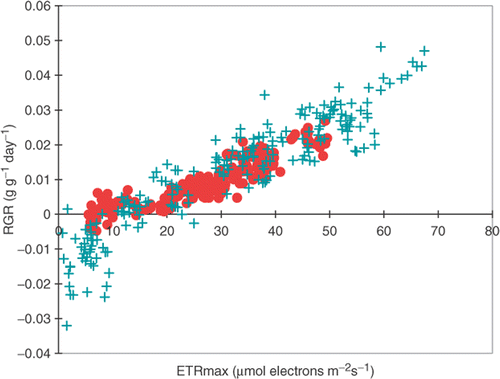
Fig. 6. Recovery of photosynthesis following exposure to high irradiance (1500 µmol m−2 s−1 PAR) for Fucus vesiculosus from the Gulf of Bothnia (northern Baltic, 5 psu) and the Irish Sea (35 psu), cultivated for 5 weeks at different salinities with high concentrations of nutrients and DIC (details as ). F v : F m after 1 h recovery at 30 µmol m−2 s−1 and 10 min dark adaptation, following exposure to high PAR for 1 h, is expressed as a percentage of initial F v/F m. Histograms show means of 10 replicates and error bars are 95% confidence limits (calculated after angular transformation of percentage data).
